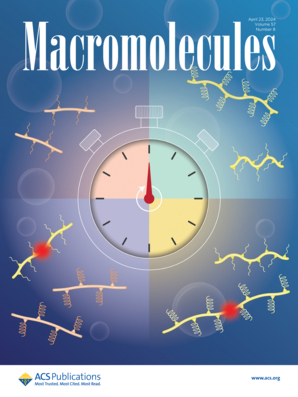One-Pot Seeded Emulsion Polymerization for Janus Particles with Various Morphologies Regulated by Monomer Plasticization and Flow Field
IF 5.1
1区 化学
Q1 POLYMER SCIENCE
引用次数: 0
Abstract
For Janus particles, it is crucial to effectively control and regulate their segmented morphologies. In this study, flow field and plasticization are introduced as novel factors in seeded emulsion polymerization, which is a widely used method for preparing Janus particles to regulate the morphology of the as-synthesized Janus particles. Rapid swelling with monomer (3-methacryloxypropyltrimethoxysilane, MPS) renders the polystyrene (PS) hollow particle seeds plasticized and deformable, while an appropriate flow field facilitates the flattening of these plasticized spherical seeds into disc-like particles. Meanwhile, the polymerization of MPS induces phase separation between the PS seeds and as-formed silica bulges, leading to the formation of PS@silica Janus particles. Thus, the deformation of the PS seeds and the growth of silica bulges are carried out in one pot. By adjusting the stirring speed and monomer ratio, Janus particles with various morphologies, from snowman-like to mushroom-like, can be achieved in a controlled manner. Consequently, the Janus balance (JB) and thus the amphiphilicity of Janus particles can be easily adjusted through the degree of seed deformation, allowing for their further application as solid surfactants to stabilize Pickering emulsions with different types and microstructures.受单体塑化和流场调控的不同形态Janus颗粒的一锅种子乳液聚合
对于Janus粒子来说,有效地控制和调节其分节形态是至关重要的。本研究引入了流场和塑化作为种子乳液聚合的新因素,这是制备Janus颗粒的一种广泛使用的方法,以调节合成的Janus颗粒的形态。单体(3-甲基丙烯氧基丙基三甲氧基硅烷,MPS)的快速膨胀使聚苯乙烯(PS)中空颗粒种子增塑化和变形,而适当的流场有利于这些增塑化的球形种子扁化成圆盘状颗粒。同时,MPS的聚合导致PS种子与形成的二氧化硅隆起物相分离,从而形成PS@silica Janus颗粒。因此,PS种子的变形和硅胶膨出在一个锅中进行。通过调节搅拌速度和单体比例,可以有控制地获得从雪人到蘑菇形状的各种形态的Janus颗粒。因此,Janus平衡(JB)和Janus颗粒的两亲性可以很容易地通过种子的变形程度来调节,从而允许它们作为固体表面活性剂进一步应用于稳定具有不同类型和微观结构的皮克林乳状液。
本文章由计算机程序翻译,如有差异,请以英文原文为准。
求助全文
约1分钟内获得全文
求助全文
来源期刊

Macromolecules
工程技术-高分子科学
CiteScore
9.30
自引率
16.40%
发文量
942
审稿时长
2 months
期刊介绍:
Macromolecules publishes original, fundamental, and impactful research on all aspects of polymer science. Topics of interest include synthesis (e.g., controlled polymerizations, polymerization catalysis, post polymerization modification, new monomer structures and polymer architectures, and polymerization mechanisms/kinetics analysis); phase behavior, thermodynamics, dynamic, and ordering/disordering phenomena (e.g., self-assembly, gelation, crystallization, solution/melt/solid-state characteristics); structure and properties (e.g., mechanical and rheological properties, surface/interfacial characteristics, electronic and transport properties); new state of the art characterization (e.g., spectroscopy, scattering, microscopy, rheology), simulation (e.g., Monte Carlo, molecular dynamics, multi-scale/coarse-grained modeling), and theoretical methods. Renewable/sustainable polymers, polymer networks, responsive polymers, electro-, magneto- and opto-active macromolecules, inorganic polymers, charge-transporting polymers (ion-containing, semiconducting, and conducting), nanostructured polymers, and polymer composites are also of interest. Typical papers published in Macromolecules showcase important and innovative concepts, experimental methods/observations, and theoretical/computational approaches that demonstrate a fundamental advance in the understanding of polymers.
 求助内容:
求助内容: 应助结果提醒方式:
应助结果提醒方式:


